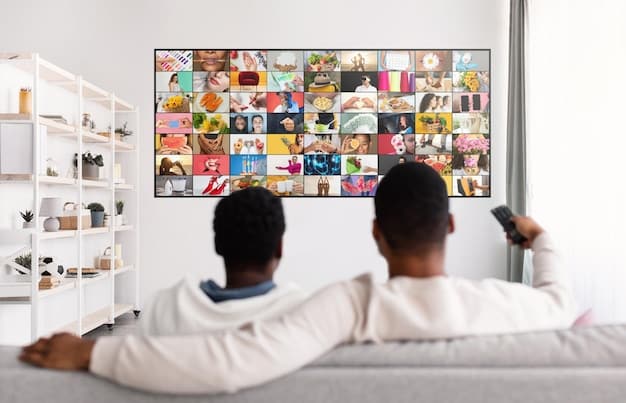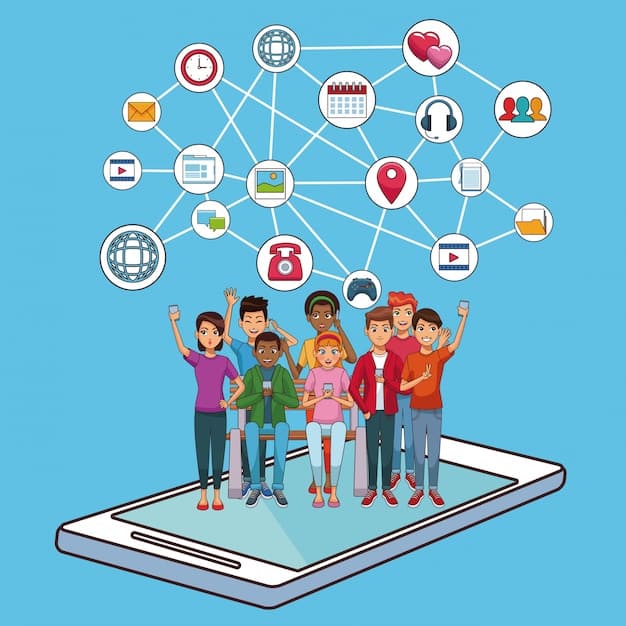Social Media’s Impact on Reality TV Ratings: A 5-Year Analysis

The advent of social media has fundamentally reshaped the landscape of reality television, influencing everything from audience engagement and show promotion to casting decisions and the very narratives presented, a dynamic that has become increasingly critical for understanding viewership trends over the past five years.
Delving into how digital platforms have reshaped our viewing habits, this study explores The Impact of Social Media on Reality TV Ratings: A 5-Year Study. We’ll uncover how the real-time commentary, fan theories, and direct interactions afforded by social media have become indispensable components of the reality television experience, profoundly affecting its viewership and longevity.
The Symbiotic Relationship: Social Media and Reality TV Explained
The relationship between social media and reality television has evolved from a mere coincidence into a fully synergistic system over the last five years. Reality TV shows, inherently designed to provoke discussion and emotional responses, found a perfect echo chamber in platforms like Twitter, Instagram, and TikTok. These digital spaces act as real-time forums where viewers can react, debate, and even influence the ongoing narrative of their favorite shows. The immediacy of social media transformed passive viewing into an active, communal experience.
This dynamic interaction amplifies the content’s reach and provides an invaluable feedback loop for producers and networks. Before social media reached its current ubiquity, audience reaction was largely measured by traditional means like focus groups or Nielsen ratings, often delayed and less granular. Now, a deluge of data points, from trending topics and meme creation to sentiment analysis, offers immediate insights into public perception. This constant stream of feedback not only helps shape current seasons but also informs the development of future reality TV concepts, creating a responsive and adaptive entertainment ecosystem.
Social media’s role extends beyond mere discussion; it fosters a sense of community among viewers. Fans connect with each other, share theories, and form alliances, making the viewing experience richer and more engaging. This communal aspect is what differentiates reality TV from many other genres; it’s not just about watching a show, but about being part of a larger conversation. The more engaged viewers are on social media, the more likely they are to tune in for live broadcasts or catch up on episodes, driving up engagement and, subsequently, ratings. The interactive nature of social media creates an ecosystem where every tweet, every comment, and every share contributes to the overall buzz and relevance of a reality TV show.
The Rise of Live-Tweeting and Fan Engagement
Live-tweeting has become a ritual for many reality TV fans. As episodes air, viewers flock to platforms like Twitter to share their instant reactions, often creating trending topics that expose the show to wider audiences. This real-time engagement transforms watching television into a shared event.
- Increased buzz and visibility, attracting new viewers.
- Creation of viral moments and memes, extending content lifespan.
- Direct interaction between fans, fostering a strong community.
This active participation not only enhances the viewing experience for current fans but also serves as a powerful, organic marketing tool. The excitement generated on social media organically draws in curious new viewers who want to understand the trending conversations, further boosting the show’s reach and potential ratings.
Feedback Loops and Narrative Influence
Networks and production companies closely monitor social media discussions. Fan theories, popular opinions, and even criticisms can subtly, or sometimes overtly, influence story arcs, character portrayals, and future plot developments. This responsive approach makes viewers feel more invested.
- Direct audience insights for producers and writers.
- Opportunities to course-correct or amplify popular storylines.
- Enhanced viewer loyalty through perceived influence.
This continuous feedback mechanism transforms the traditional unidirectional flow of broadcast media into a dynamic, interactive dialogue, where the audience’s voice holds measurable sway in the creative process. It creates a sense of shared ownership, making the audience more invested in the show’s success and narrative evolution. Ultimately, this symbiotic relationship helps reality TV remain relevant and engaging in an increasingly fragmented media landscape. Viewers are no longer just consumers; they are active participants in the show’s journey.
Ultimately, the past five years have cemented social media’s role as an indispensable companion to reality television. It has transformed viewing from a solitary activity into a collective, interactive experience, directly impacting how shows are consumed, discussed, and even produced, thereby significantly influencing their ratings.
Audience Engagement Metrics: Beyond the Traditional Ratings
The traditional model of measuring television viewership, primarily via Nielsen ratings, once stood as the sole arbiter of success. However, the prolific rise of social media platforms has introduced a new, nuanced layer to understanding audience engagement. Networks and advertisers are increasingly looking beyond mere viewer numbers to encompass a broader spectrum of metrics that indicate a show’s true cultural impact and longevity. These new metrics provide a more holistic view of a program’s influence and reach, moving beyond simple impressions to capture active participation and emotional investment.
Social media allows for the collection of an unprecedented amount of qualitative and quantitative data. Metrics such as sentiment analysis (identifying positive, negative, or neutral reactions to a show), trending topics (how often a show or its cast members appear in trending lists), and volume of mentions (the sheer number of times a show is discussed) offer deeper insights than traditional demographics alone. These indicators reveal not just how many people are watching, but how deeply they are connecting with the content and how much they care about its characters and storylines. A show might have moderate traditional ratings but generate immense social media buzz, often indicating a highly engaged a passionate fan base likely to tune in week after week.
This expanded understanding of engagement directly influences advertising strategies. Brands are willing to pay more to associate with shows that generate high social media engagement, recognizing the value of direct interaction with an active and vocal audience. An engaged audience is more likely to remember product placements, participate in brand discussions, and even become advocates for products seen within the show. Thus, social media metrics have become a crucial component in valuing a reality TV property, shifting the focus from simply eyeballs to influential eyeballs.
The Shift from Passive to Active Consumption
Social media platforms like TikTok, Instagram, and X (formerly Twitter) have transformed the act of watching reality TV from a passive activity into an active, participatory event. Viewers are no longer just consuming content; they are creating it, sharing it, and discussing it in real-time. This hands-on involvement creates a far deeper connection between the audience and the show.
- Viewers become content creators (memes, fan edits, commentary).
- Real-time interaction during live broadcasts amplifies viewership.
- Direct engagement fosters a stronger, more invested fan base.
This active participation translates into more consistent viewership and a higher likelihood of audience retention. When viewers feel personally invested and heard, they are more inclined to remain loyal to a show and even champion it within their social circles, extending its reach and influence.
Influence on Ad Spend and Brand Partnerships
Advertisers recognize that high social media engagement translates into valuable exposure. Brands are increasingly targeting shows that generate significant online discussion, leveraging the show’s audience to create organic conversations around their products or services. This symbiotic relationship provides a powerful mechanism for both show monetization and brand visibility.
- Higher social media metrics can lead to increased ad revenue.
- Opportunities for integrated brand partnerships and native advertising.
- Direct access to highly engaged, targeted demographics.
Ultimately, the evolution of audience engagement metrics underscores a fundamental shift in how media success is defined. It’s no longer just about who’s watching, but about how deeply they are engaging and how vigorously they are participating in the conversation, making social media a foundational pillar in understanding the true impact of reality television.
Casting and Narrative Evolution: Reflecting the Social Conversation
The rise of social media has undeniably reshaped the casting process and the evolving narratives within reality television over the past five years. Gone are the days when casting directors operated in a largely insulated bubble, relying predominantly on traditional auditions and personal networks. Today, social media platforms serve as powerful scouting grounds, offering unparalleled access to potential cast members who already possess an established online presence and a ready-made fan base. This shift means that individuals with compelling stories or captivating personalities that resonate within specific online communities are often prioritized, even before they officially step onto a show’s set. The ability to “go viral” or maintain a strong, engaging feed can be as valuable as, if not more valuable than, conventional on-screen charisma.
Furthermore, social media provides an immediate and unfiltered reflection of public opinion, a critical factor influencing narrative development. Showrunners and producers actively monitor discussions, fan theories, and public sentiment to gauge what storylines are resonating, which characters are beloved or reviled, and where the audience hopes the plot will go next. This direct feedback loop allows for a remarkable degree of responsiveness, enabling shows to pivot narratives, highlight fan-favorite cast members, or even address public controversies in real-time. While this responsiveness can make shows feel more current and relevant, it also introduces challenges, as producers must balance creative integrity with commercial pressures and the often-fickle nature of online discourse.
The integration of social media into casting and narrative has democratized access to the reality TV space in some ways, allowing everyday people to become overnight sensations simply by having a captivating online persona. This organic discovery process, fueled by viral content and internet fame, injects a fresh level of authenticity and unpredictability into shows. However, it also places immense pressure on cast members to maintain their online persona, navigate public scrutiny, and often, generate drama specifically for social media consumption, further blurring the lines between their real lives and their on-screen personalities.

The Influence of Online Persona in Casting
Today, an aspiring reality TV star’s digital footprint is almost as crucial as their audition tape. Casting directors seek individuals who not only fit the show’s theme but also have engaging online personalities, followers, and the potential to generate buzz.
- Selection based on pre-existing social media popularity.
- Emphasis on individuals who can create controversy or viral moments.
- Diversification of cast members based on online communities.
This proactive scanning of online presences ensures that new cast members come with a built-in audience, making them more valuable assets in terms of drawing in viewers and sparking immediate social media conversations. It also means that candidates are often chosen for their capacity to produce consumable digital content, such as memes or quotable moments, even before filming begins.
Real-Time Narrative Adjustment and Audience-Driven Storylines
Social media acts as a focus group on steroids, offering producers immediate insights into viewer preferences. This real-time feedback can lead to adjustments in storylines, character arcs, and even editing decisions, making shows more responsive to audience desires.
- Producers adapting narratives based on trending topics.
- Highlighting characters or relationships popular with viewers.
- Addressing fan criticisms or theories within the show’s narrative.
This dynamic interaction ensures that reality TV remains highly relevant and engaging, as shows can adapt their content to mirror the very conversations happening online. The audience, in a way, becomes a co-creator, wielding significant influence over the direction and development of the beloved programs. This shift transforms passive consumption into an interactive dialogue, where the viewer feels deeply invested in the narrative’s progression and individual character trajectories. Ultimately, this integration elevates audience engagement, bolstering ratings and ensuring the show’s persistent cultural resonance.
Challenges and Ethical Considerations: The Double-Edged Sword
While the symbiotic relationship between social media and reality TV has fueled unprecedented engagement and reach, it also presents a complex array of challenges and ethical considerations. The very platforms that amplify a show’s buzz can also become breeding grounds for intense scrutiny, misinformation, and cyberbullying, transforming the digital landscape into a double-edged sword for both the shows and their participants. Over the past five years, the industry has grappled with the moral implications of this constant public exposure, particularly concerning the mental health and privacy of cast members.
The real-time nature of social media commentary means that cast members are subjected to immediate, unfiltered public opinion, often ranging from casual criticism to vicious personal attacks. Unlike traditional media, where reviews are often curated and published by gatekeepers, social media removes these filters, allowing anyone with an internet connection to weigh in. This constant barrage of feedback, both positive and negative, can take a severe toll on the mental well-being of individuals who are often thrust into the spotlight without adequate psychological support. Issues like anxiety, depression, and even suicide ideation have been linked to intense online harassment, leading to calls for greater protection and stricter platform moderation from within the industry.
Furthermore, the blurred lines between on-screen persona and real life, exacerbated by social media, raise significant privacy concerns. Cast members often share intimate details of their lives on camera, which are then amplified and dissected endlessly online. This constant exposure can lead to harassment in their personal lives, doxing, and a pervasive loss of privacy that extends far beyond the duration of their time on a show. The ethical dilemma lies in balancing the entertainment value derived from authentic, often vulnerable, human experiences with the responsibility to protect individuals from the darker side of online fame. The industry is increasingly under pressure to implement clearer guidelines, provide robust mental health resources, and foster a more responsible digital environment for its participants.
Cyberbullying and Mental Health Impacts
The immediacy and anonymity of social media allow for widespread cyberbullying, often targeting reality TV cast members. The constant barrage of criticism, hate messages, and personal attacks can severely impact their mental health, leading to anxiety, depression, and in extreme cases, more severe outcomes.
- Increased scrutiny leading to psychological distress for cast members.
- Public shaming and relentless online harassment.
- Pressure on networks to provide mental health support.
This relentless scrutiny turns social media into a battlefield, where participants are often ill-equipped to handle the overwhelming negativity. The ethical responsibility of reality TV producers to protect their casts from online toxicity has become a pressing concern, pushing for better protective measures and mental health resources to mitigate the profound psychological toll.
Authenticity vs. Performance for the Camera
The awareness that every action may be dissected and commented on social media can influence authenticity. Cast members might consciously or unconsciously perform for the online audience, blurring the lines between reality and curated persona, and potentially undermining the “reality” in reality TV.
- Cast members fabricating drama for social media buzz.
- Pressure to maintain a popular online image, even off-screen.
- Erosion of genuine interactions due to performative behavior.
This dynamic poses a significant challenge to the integrity of reality television, as the authenticity that initially drew viewers to the genre can be compromised by the ever-present gaze of social media. The constant pressure to generate shareable content can lead to contrived scenarios, diminishing the genuine connection viewers seek, thus making the ethical balance between entertainment and real-life consequences a critical challenge for producers.
Monetization and Future Outlook: Beyond Ad Revenue
The financial landscape of reality television has undergone a significant transformation over the past five years, largely due to the pervasive influence of social media. While traditional advertising revenue remains a core component, networks and production companies are increasingly exploring diversified monetization strategies that leverage the unique opportunities presented by digital platforms. This shift reflects a recognition that audience engagement on social media can be converted into tangible economic value far beyond mere viewership numbers, creating a more robust and multifaceted business model for the genre.
One of the most prominent new avenues for monetization is direct-to-consumer engagement. Reality TV stars, leveraging their newfound or amplified social media fame, often launch their own brands, products, or services. From beauty lines and fashion collections to podcasts and personal appearances, these ventures capitalize on the emotional connection and loyalty cultivated with their fan bases through the show and consistent social media interaction. The show itself becomes a powerful incubator for entrepreneurial ventures, turning participants into influencers with substantial earning potential. Networks can then participate in these ventures through various licensing deals or revenue-sharing agreements, creating a new source of income.
Furthermore, social media enables innovative advertising formats that integrate products and services more seamlessly into the reality TV experience. Influencer marketing, where cast members promote brands organically through their own social media channels, has become a highly effective strategy. This approach offers advertisers a more authentic and relatable way to reach audiences, often yielding higher engagement rates than traditional commercials. The future outlook suggests a continued refinement of these strategies, with an emphasis on creating immersive experiences that extend beyond the linear broadcast. Think interactive content, virtual reality extensions, and exclusive digital experiences that offer premium access to reality TV universes, opening up new subscription and pay-per-view opportunities, further solidifying social media’s role not just as a promotional tool, but as a direct revenue generator.
The Rise of “Influencer” Cast Members
Many reality TV participants leverage their on-screen exposure to build massive social media followings, transforming into legitimate influencers. This allows them to secure lucrative brand deals, endorsements, and sponsorships outside of their television contracts, creating a new revenue stream fueled directly by their show appearances.
- Personal brand building and product endorsements.
- Direct-to-consumer sales of merchandise or services.
- Post-show career longevity enhanced by digital presence.
This parallel career path has become almost as crucial as the on-screen narrative for many cast members, turning their show appearance into a launchpad for long-term digital entrepreneurship. Their sustained online presence ensures continued relevance and financial stability, well beyond the confines of a single season.
New Advertising Models and Brand Integrations
Beyond traditional commercial breaks, social media facilitates more nuanced advertising placements. Brands can partner with cast members for targeted campaigns, integrate products into organic social media content, or even sponsor entire digital segments of a show, offering more dynamic and engaging ways to reach consumers.
- Native advertising, often through cast members’ personal accounts.
- Sponsored digital content and exclusive online show extensions.
- Data-driven ad targeting based on social media audience demographics.
These evolving models ensure that advertisements are less intrusive and more relevant to the engaged audience, ultimately yielding better results for both advertisers and networks. The future anticipates even more sophisticated integrations, where advertising becomes an indistinguishable part of the content experience, transforming mere viewers into active, consuming participants. This sophisticated approach to brand integration, driven by the vast data and direct access social media provides, is set to redefine the monetization strategies for reality television for years to come. Ultimately, social media isn’t just a marketing tool; it’s a fundamental pillar of the reality TV business model.
Data Analytics and Predictive Modeling in Viewership
The integration of social media data analytics has revolutionized how networks approach viewership predictions and strategic planning for reality television over the past five years. Traditionally, anticipating audience behavior relied heavily on historical Nielsen ratings and demographic profiles. However, with the explosion of real-time conversations, trend analysis, and sentiment tracking on platforms like X, Instagram, and TikTok, a wealth of granular data is now available, enabling a much more sophisticated and nuanced understanding of audience preferences and potential viewership spikes. This shift represents a significant leap from retrospective analysis to proactive, data-driven decision-making.
Networks now employ advanced data analytics tools to process the immense volume of social media discussions related to their reality TV shows. Machine learning algorithms can identify emerging trends, pinpoint fan favorite moments or characters, and even predict potential controversies before they fully erupt. By analyzing positive or negative sentiment around specific storylines or cast members, producers can gain early insights into how their content is being received, allowing for agile adjustments in editing, promotional strategies, or even future casting. This predictive modeling capability dramatically reduces the guesswork involved in television production and scheduling, moving towards a more scientifically informed approach.
Moreover, social media data offers a powerful means to understand the “why” behind viewership numbers. It can explain unexpected surges in ratings (perhaps due to a viral clip or a trending hashtag) or declines (linked to audience dissatisfaction expressed online). This depth of insight allows networks to optimize their programming schedules, identify optimal premiere dates, and even cross-promote shows more effectively by understanding audience crossovers between different reality TV franchises. The future of reality TV ratings will increasingly depend on the sophisticated interpretation of these vast datasets, transforming the art of show production into a data-science-driven endeavor.
Leveraging Social Listening for Audience Insights
Social listening tools actively monitor mentions, hashtags, and discussions related to reality TV shows across various platforms. This continuous stream of data provides unparalleled insights into audience sentiment, character popularity, and plot preferences.
- Understanding real-time audience reactions to episodes.
- Identifying popular narratives and unexpected fan theories.
- Gauging public perception of specific cast members.
This granular understanding allows networks to fine-tune their content and marketing efforts, ensuring that their shows remain in alignment with audience desires, thereby potentially improving viewership and overall show longevity through targeted content adjustments.
Predictive Analytics for Schedule Optimization
By analyzing social media trends and engagement patterns, networks can employ predictive analytics to optimize their programming schedules. This includes determining ideal slot times, planning strategic promotional campaigns, and even predicting the potential success of new reality TV concepts based on similar past social media buzz.
- Forecasting potential viewership based on social media buzz.
- Optimizing episode release times for maximum engagement.
- Identifying cross-promotional opportunities between shows.
This proactive use of data allows networks to minimize risks and maximize the potential reach and impact of their reality TV offerings. The move away from solely relying on historical data to incorporating real-time social indicators marks a significant evolution in how television content is strategized and produced. Ultimately, the fusion of social media data with predictive modeling creates a powerful framework for the future of reality TV, ensuring that decisions are no longer made in isolation but are deeply informed by the collective voice of the audience, leading to smarter scheduling and potentially higher ratings.
The Future Landscape: Immersive Experiences and Metaverse Engagement
The trajectory of social media’s impact on reality TV ratings over the next five years points towards an even more immersive and integrated viewing experience, potentially extending into realms like the metaverse. As technology evolves and social platforms become more sophisticated, the line between consuming media and participating in it will continue to blur, offering unprecedented opportunities for engagement and, consequently, for influencing viewership. The future looks less like passive watching and more like active dwelling within the reality TV universe.
Imagine a scenario where viewers aren’t just tweeting about a show, but are literally “living” within its digital extension. This could manifest as virtual reality experiences where fans can explore the sets, interact with digital avatars of cast members, or even participate in virtual challenges mirroring those on screen. The metaverse offers a persistent, shared online space where these kinds of immersive experiences can flourish, transforming a two-dimensional broadcast into a three-dimensional, interactive world. This level of engagement promises to deepen fan loyalty, turning casual viewers into dedicated participants, which would naturally reflect in sustained or increased viewership numbers as the draw to “be part of the show” intensifies.
Furthermore, the evolution of social media will likely foster even more personalized and interactive content. AI-driven recommendations, tailored narrative paths based on viewer preferences, and direct, real-time voting mechanisms across multiple platforms could redefine how shows are shaped. This hyper-personalization, coupled with enhanced social connectivity within these digital environments, will create unique micro-communities around specific shows or even individual cast members. As these communities grow and their members become more deeply enmeshed in the narrative, their dedication will drive consistent viewership and evangelism for the content, making the distinction between audience member and active participant increasingly tenuous. The future of reality TV ratings will hinge not just on the number of eyes on screen, but on the depth of immersion and participation in its expanded digital ecosystem.
Virtual Reality and Augmented Reality Extensions
The move towards VR and AR promises to revolutionize reality TV. Imagine exploring the set of “Big Brother” in VR or having augmented reality elements pop up on your screen that provide additional context about contestants. These immersive experiences can transform abstract fan engagement into tangible, interactive realities.
- Viewers experiencing show environments in VR.
- AR overlays providing interactive data and hidden content.
- Increased willingness to pay for premium immersive content.
This advanced level of immersion will likely translate into a more dedicated viewership, as fans become more deeply invested in the show’s world, creating a loyal audience less prone to attrition. The novelty and interactivity of these technologies will draw in a new demographic of technologically savvy viewers, expanding the overall reach and appeal of reality TV.
Interactive and Personalized Narratives via Social Platforms
Future social media integrations will allow for even more direct influence on narratives. Polls and direct feedback could shape episode outcomes or character interactions in real-time, making viewers feel like co-creators. Personalized storylines, tailored by AI based on individual historical engagement, could further deepen the connection.
- Real-time voting influencing show outcomes.
- AI-driven content recommendations based on viewer interaction.
- Interactive elements that empower direct audience participation.
This co-creative approach not only heightens audience investment but also keeps the content fresh and relevant. The personalized touch means that reality TV can evolve to become an individual journey for each viewer, rather than a one-size-fits-all broadcast, ensuring a stronger, more consistent viewership base for years to come. Ultimately, the metaverse and ever-deeper interactivity stand to amplify social media’s role, ensuring reality TV remains a dominant force in popular culture by embedding it directly into the fabric of daily digital life. This continuous evolution will ensure the genre’s longevity and its continued influence on ratings by fostering an unprecedented depth of audience integration.
| Key Point | Brief Description |
|---|---|
| 💬 Social Synergy | Social media transforms viewing into a shared, interactive experience, boosting buzz and reach. |
| 📈 Beyond Ratings | New engagement metrics like sentiment analysis offer deeper insights into audience impact. |
| 🎭 Narrative Evolution | Online public opinion influences casting decisions and shapes show storylines. |
| 🚀 Future Immersion | Anticipate VR/AR experiences and interactive narratives driving future engagement and ratings. |
Frequently Asked Questions About Reality TV and Social Media
Social media impacts ratings by fostering real-time engagement, creating buzz, and enabling live discussions during broadcasts. This increased visibility and community engagement can encourage more viewers to tune in, watch episodes, and actively participate in conversations, thereby boosting both live viewership and on-demand consumption, directly traceable to rating changes.
While still a benchmark, Nielsen ratings are no longer the sole indicator of success. They are increasingly complemented by social media engagement metrics like sentiment analysis, trending topics, and online viewer discussions. These digital insights provide a more comprehensive picture of a show’s reach, cultural impact, and audience loyalty beyond just numerical viewership.
Reality TV shows actively scout social media for potential cast members who already have a strong online presence, engaging personalities, or viral potential. This approach helps identify individuals who can generate immediate buzz and connect with existing online communities, reducing casting risks and ensuring a built-in audience for the show.
Major ethical concerns include cyberbullying, invasion of privacy, and the mental health toll on cast members facing relentless public scrutiny. The blurred lines between their on-screen persona and personal life, amplified by constant online commentary, often lead to significant psychological distress and harassment, necessitating
better support systems for participants.
The future anticipates deeper integration, including immersive experiences through VR/AR, more personalized narratives, and enhanced interactive content. Social media will continue to drive audience engagement, potentially via metaverse extensions and direct fan influence on storylines, further solidifying its role in shaping viewership and monetization strategies for the genre.

Conclusion: The Ever-Evolving Narrative of Reality TV and Social Media
Over the past five years, the interwoven destinies of reality television and social media have only grown more entangled, creating a dynamic ecosystem that continually redefines viewership, engagement, and production. What began as a mere promotional tool has blossomed into an indispensable component of the reality TV experience, directly influencing everything from narrative development and casting choices to audience engagement metrics that now extend far beyond traditional ratings. The real-time, interactive nature of platforms like Twitter, Instagram, and TikTok has transformed passive viewers into active participants, shaping discussions, influencing plotlines, and even launching the careers of overnight stars. This symbiotic relationship has unlocked unprecedented levels of buzz and reach, demonstrating that a show’s success is increasingly measured not just by who watches, but by how deeply they engage online. As we look to the future, the trends suggest an even more immersive landscape, with virtual reality, augmented reality, and personalized narratives poised to deepen this connection further. While challenges such as cyberbullying and authenticity remain, the undeniable impact of social media has fundamentally reshaped reality television, ensuring its continued relevance and dynamic pull on audiences worldwide.





